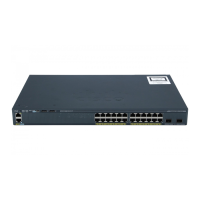31-14
Catalyst 2950 and Catalyst 2955 Switch Software Configuration Guide
78-11380-12
Chapter 31 Troubleshooting
Preventing Autonegotiation Mismatches
Preventing Autonegotiation Mismatches
The IEEE 802.3ab autonegotiation protocol manages the switch settings for speed (10 Mbps, 100 Mbps,
and 1000 Mbps excluding GBIC ports) and duplex (half or full). There are situations when this protocol
can incorrectly align these settings, reducing performance. A mismatch occurs under these
circumstances:
• A manually set speed or duplex parameter is different from the manually set speed or duplex
parameter on the connected port.
• A port is set to autonegotiate, and the connected port is set to full duplex with no autonegotiation.
To maximize switch performance and ensure a link, follow one of these guidelines when changing the
settings for duplex and speed:
• Let both ports autonegotiate both speed and duplex.
• Manually set the speed and duplex parameters for the ports on both ends of the connection.
Note If a remote device does not autonegotiate, configure the duplex settings on the two ports to match. The
speed parameter can adjust itself even if the connected port does not autonegotiate.
GBIC and SFP Module Security and Identification
Cisco Course Wave Division Multiplexer (CWDM) Gigabit Interface Converter (GBIC) and small
form-factor pluggable (SFP) modules have a serial EEPROM that contains the module serial number, the
vendor name and ID, a unique security code, and cyclic redundancy check (CRC). When a CWDM GBIC
or SFP module is inserted in the switch, the switch software reads the EEPROM to check the serial
number, vendor name and vendor ID, and recompute the security code and CRC. If the serial number,
the vendor name or vendor ID, the security code, or CRC is invalid, the switch places the interface in an
error-disabled state.
Note If you are using a non-Cisco CWDM GBIC or SFP module, remove the GBIC or SFP module from the
switch, and replace it with a Cisco module.
After inserting a Cisco GBIC or SFP module, use the errdisable recovery cause gbic-invalid global
configuration command to verify the port status, and enter a time interval for recovering from the
error-disabled state. After the elapsed interval, the switch brings the interface out of the error-disabled
state and retries the operation. For more information about the errdisable recovery command, see the
command reference for this release.
Diagnosing Connectivity Problems
This section describes how to troubleshoot connectivity problems:
• Using Ping, page 31-15
• Using Layer 2 Traceroute, page 31-16

